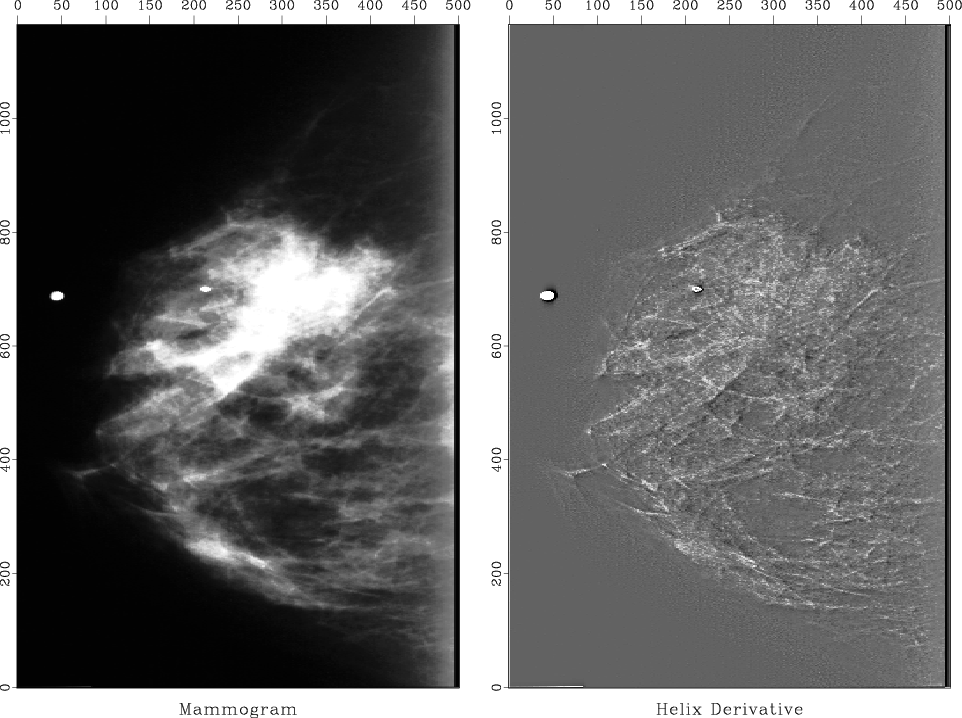|
|
|
|
The helical coordinate |
|
mam
Figure 13. Mammogram (medical X-ray). The cancer is the ``spoked wheel.'' (I apologize for the inability of paper publishing technology to exhibit a clear grey image.) The tiny white circles are metal foil used for navigation. The little halo around a circle exhibits the impulse response of the helix derivative. |

|
|---|---|
|
|
I prepared a half dozen medical X-rays like Figure 13. The doctor brought her young son to my office one evening to evaluate the results. In a dark room, I would show the original X-ray on a big screen and then suddenly switch to the helix derivative. Every time I did this, her son would exclaim ``Wow!'' The doctor was not so easily impressed, however. She was not accustomed to the unfamiliar image. Fundamentally, the helix derivative applied to her data does compress the dynamic range making weaker features more readily discernible. We were sure of this from theory and various geophysical examples. The subjective problem was her unfamiliarity with our display. I found that I could always spot anomalies more quickly on the filtered display, but then I would feel more comfortable when I would discover those same anomalies also present (though less evident) in the original data. Retrospectively, I felt the doctor would likely have been equally impressed had I used a spatial low-cut filter instead of the helix derivative. This simpler filter would have left the details of her image unchanged (above the cutoff frequency), altering only the low frequencies, thereby allowing me to increase the gain.
First, I had a problem preparing Figure 13.
It shows the application of the helix derivative
to a medical X-ray.
The problem was that the original X-ray was all positive
values of brightness, so there was a massive amount of
spatial low frequency present.
Obviously, an ![]() -derivative or a
-derivative or a ![]() -derivative would
eliminate the low frequency, but the helix derivative did not.
This unpleasant surprise arises
because the filter in equation
(13)
was truncated after a finite number of terms.
Adding up the terms actually displayed in equation
(13),
the sum comes to .183, whereas, theoretically the sum of all the terms should be zero.
From the ratio of .183/1.791,
we can say the filter pushes zero-frequency amplitude 90% of the way to zero value.
When the image contains very much zero-frequency amplitude,
more coefficients are needed.
I did use more, but simply removing the mean saved me
from needing a costly number of filter coefficients.
-derivative would
eliminate the low frequency, but the helix derivative did not.
This unpleasant surprise arises
because the filter in equation
(13)
was truncated after a finite number of terms.
Adding up the terms actually displayed in equation
(13),
the sum comes to .183, whereas, theoretically the sum of all the terms should be zero.
From the ratio of .183/1.791,
we can say the filter pushes zero-frequency amplitude 90% of the way to zero value.
When the image contains very much zero-frequency amplitude,
more coefficients are needed.
I did use more, but simply removing the mean saved me
from needing a costly number of filter coefficients.
A final word about the doctor. As she was about to leave my office she suddenly asked if I had scratched one of her X-rays. We were looking at the helix derivative, and it did seem to show a big scratch. What should have been a line was broken into a string of dots. I apologized in advance and handed her the original film negatives, which she proceeded to inspect. ``Oh,'' she said, ``Bad news. There are calcification nodules along the ducts.'' So, the scratch was not a scratch, instead an important detail had not been noticed on the original X-ray. Times have changed since then. Nowadays, mammography has become digital; and appropriate filtering is defaulted in the presentation.
In preparing an illustration for here, I learned one more lesson. The scratch was a small part of a big image, so I enlarged a small portion of the mammogram for display here. The very process of selecting a small portion followed by scaling the amplitude between maximum and minimum darkness of printer ink had the effect enhancing the visibility of the scratch on the mammogram. Now, Figure 14 shows the two calcification nodule strings perhaps even clearer than on the helix derivative.

|
|---|
|
scratch
Figure 14. Not a scratch. Reducing the |
|
|
|
|
|
|
The helical coordinate |